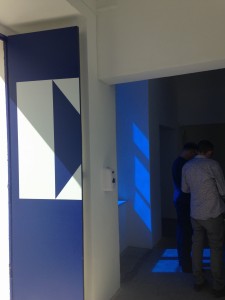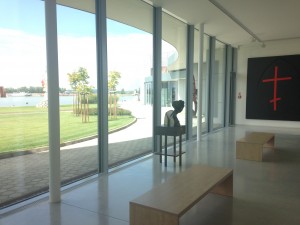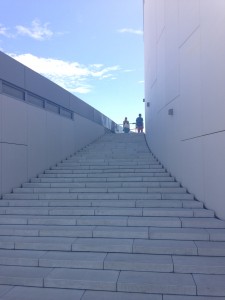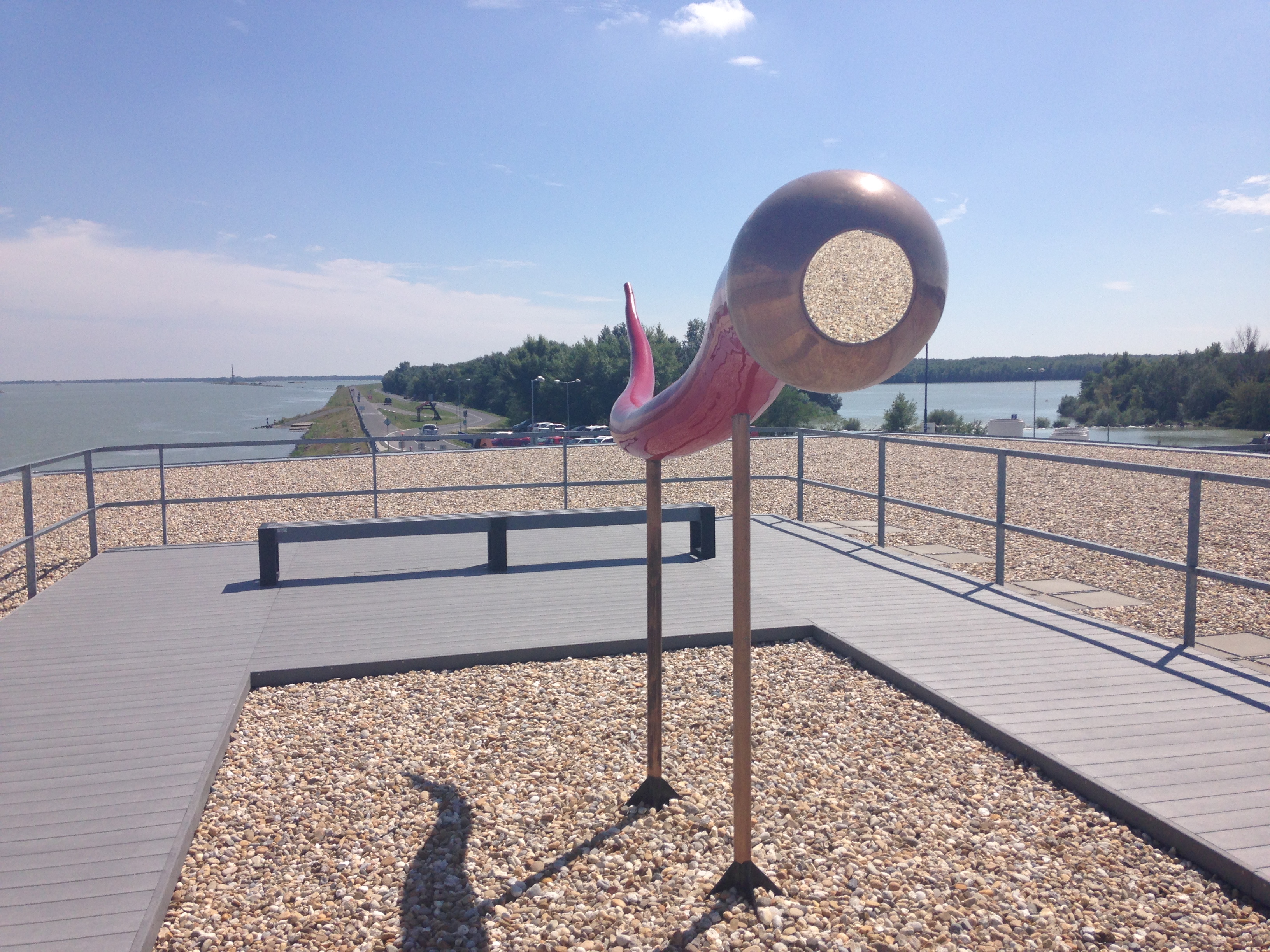Contemporary art makes a new box, then thinks outside of it. That’s my experience of the last two Berlin Biennales. If the 8th Biennale majored on hard-hitting documentaries which, with one notable exception, offered little in the way of hope, the 9th (on till 18th September) gives us utopias: “This is a format that works for everything where speaking and selling collapse in the principle of exchange. This is how the intangible becomes real, and the real incomprehensible.”

Meaning…? Let’s take three of the video pieces. At the Akademie der Künste (Academy of Art), Hallin Altındere’s Homeland begins with hipsters doing yoga on the idyllic Turkish coast. The instructor invites them to be aware of their surroundings. But they’re oblivious to what the camera forces us to see: on the beach, refugees prepare to swim through the waters. And refugees of all nationalities – including white Europeans. Later, on land, they break through a security fence and do hip-hop to dodge the tear gas. They travel into Berlin on top of a train – recalling the perilous daily commute to work in cities like Mumbai. Of course a computer did that bit – but can we honestly say it’s not real? The intangible becomes uncomfortably real for us in its challenge, yet we struggle to understand this reality…
New Eelam, by Christopher Kulendran Thomas, is a website/documentary film – or “docu-fiction”. It begins as an account of the failed attempt of the Tamils to establish a separate state (Eelam) in Sri Lanka. Thomas attributes the failure ultimately to the seduction of global capitalism, which means the end of settled, nationally bordered life. But here lies a new opportunity, he believes: “Streaming homes. Flexible housing for global citizens.” With liquid citizenship and a flat-rate subscription, you have access to “beautifully designed homes around the world”, in the trendiest urban districts. Is this real? What if you need healthcare? Maybe that’s the point. Perhaps it’s up to us to make this utopian vision real, if we want it enough.
Far more challenging is The Army of Love, at the KW Institute, a place that’s arguably the epicentre of Berlin’s (and Europe’s) contemporary art scene. This 40-minute video presents a real live (well, probably…) project, called “Completism”. Completism challenges both capitalism’s and socialism’s failure to distribute love and intimacy equally. Many people miss out on love because they’re deemed unattractive. And the urban lonely… Filmed in a Berlin thermal spa, participants – some in swimsuits, some nude – are holding and slowly moving each other through the water. This, and another dream-like scene of slow contact choreography on the poolside (with eye-catching costumes), are interspersed with interviews, focussing on what each individual thinks makes them attractive. Particularly touching are the beautiful smile of a young woman with cerebral palsy, and an older, severely disabled man, who believes his ability to listen makes him sexually attractive to women. There are hugs a-plenty and caressing, sometimes sexually explicit. According to its website, The Army of Love – set up by film-maker Alexa Karolinski and novelist Ingo Niermann, among others – is both inspired by Christian love of neighbour and critiques it for excluding “all sensual manifestations of love”. The Army of Love will be drilled to love everyone and receive love from everyone, including on the sexual level, and sex-workers are invoked as an inspiration. The Army of Love is recruiting at the Wiesbaden Biennale.
But are we prepared to really love everyone, and be loved? Surely that’s the prime question, especially for Christians. And where does sexuality fit in? Yet I was left asking myself – would all that free sex be little more than brief respites in lonely lives? And the actors in the film – were they really committed to love each other, or was it “just a film”? Did they call each other afterwards? And what if someone wants you to have a child with them, to commit to helping nurse their disabled parent/sibling/child? How far will you go? After Berlin I went to stay in a community of the Catholic Jesuit religious order near Bratislava. Most of the priests were elderly, many sick as a result of the brutal treatment they received in prisons and labour camps under the pre-1989 Communist regime. They are nursed by Franciscan nuns, who give them much more than care. I saw these committed celibates show them a love (which included a lot of hugs and hand-holding) that transfigured suffering and frailty into a luminous beauty. This was for real – but you’d need to see it to know what I mean. I’d like to have the nuns and The Army of Love in conversation.
Bratislava also yielded some treasures of contemporary art. Whereas in Berlin artists and their venues have settled in the inner ring of districts – Prenzlauer Berg, Friedrichshain, Kreuzberg etc. – in Bratislava they’re thronging the historic centre. They prevent this gem of a city – just an hour by train from Vienna – from becoming, for all its loveliness, yet another museum. So just round the corner from the house where Mozart gave a concert at the age of six, you walk through a Baroque doorway and there’s quirky F7 gallery. Up by St Michael’s Gate, Flat Gallery is an actual inhabited flat. Across the street, a boutique has a gallery in its back room.

But the Danubiana Meulensteen Art Museum blew me away. It is, quite simply, a spiritual place. Half an hour by bus from Bratislava, its position on an island in the Danube, right next to the Austrian and Hungarian borders, is a conscious celebration both of Slovakia’s lush natural beauty and its European outlook. Founded by the Dutch entrepreneur and art collector Gerard Meulensteen and Slovak gallerist Vincent Polakovič, the Danubiana opened in 2000 and was extended in 2010. When I visited, it was hosting exhibitions on the COBRA movement and Miró, as well as work by contemporary Slovak, Hungarian and Macedonian artists such as Miroslav Cipar, Eszter Csurka, Kiro Urdin, and Stefan Polak, who works powerfully with Christian symbolism. It is the building, though, which is the masterpiece. A long, white structure with liquid curves opens to a cylinder: floor-to-ceiling windows achieve a complete unity between the gallery and the water, land and sky which surround it on all sides, a unity heightened by the presence of an outdoor sculpture park. But there’s more: from the park a stairway, as understated as it’s monumental, takes you on to the roof for more sculpture and a breathtaking view over the Danube and three countries.

I came away with a sense of pilgrimage: it was as if I’d been to a cathedral rather than a gallery.
Indeed, the sacred seems to be a preoccupation of many young Slovak artists and activists. Veronika Hliničanova, based in Bratislava and London, is creating Urban Sanctuary, in cooperation with two women architects. Engaging both with the potential released by increasing digitalisation and the risk that entails of total disembodiment, Urban Sanctuary seeks to create “a new architectural typology for public sacred space”, a place for a sacred experience of embodied thought, mediated by the sauna ritual of warming and cooling. It works with “intelligent” materials in the construction of the sauna, as well as natural water sources, incorporating both “religious” architecture and the “secular” public bath. Urban Sanctuary has been chosen for presentation in Helsinki Design Week on 10th September (free invitation by request – click here for information).
Reflecting on all this against the background of the ongoing crisis of social, political and spiritual vision in Britain and Europe, I came away from Slovakia with the sense that its artists are on to something, something which could heal and renew. Go see.
Dominic White is the author of The Lost Knowledge of Christ: Contemporary Spiritualities, Christian Cosmology and the Arts (Liturgical Press, 2015). He is the Arts Officer of St Dominic’s Priory, Newcastle, and a Chaplain to Newcastle and Northumbria Universities.
Image above: Danubiana Meulensteen Art Museum, Bratislava




